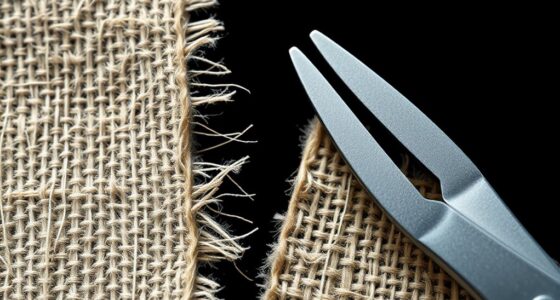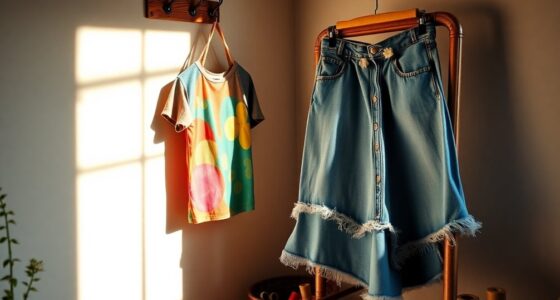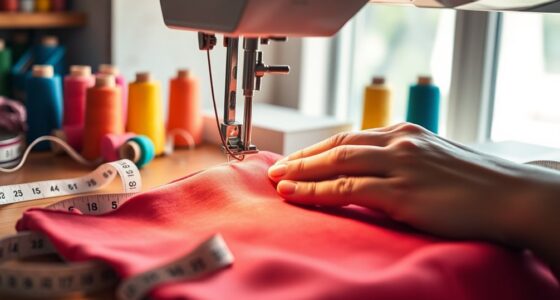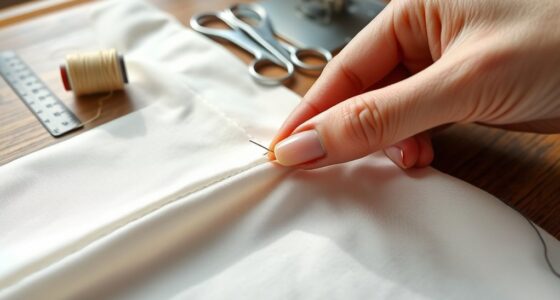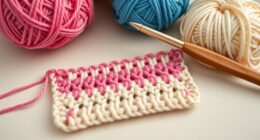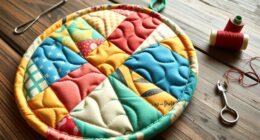Designing with negative space in modern quilts helps you achieve a balanced, striking look by intentionally leaving areas empty to highlight other elements. Use contrasting colors to create visual impact and guide the viewer’s eye naturally across the quilt. Incorporate negative space thoughtfully to bring a minimalist, sophisticated feel and guarantee proper layout and proportion. Mastering these principles makes your quilts more harmonious and artistic—keep exploring to discover how to elevate your design skills further.
Key Takeaways
- Use negative space intentionally to create visual balance and enhance the overall harmony of the quilt design.
- Incorporate contrasting colors with negative space to add depth, emphasis, and visual impact.
- Embrace minimalism by leaving areas empty, fostering a sleek and sophisticated aesthetic.
- Balance filled and unfilled areas thoughtfully to achieve a modern, clean, and proportionate layout.
- Utilize negative space as a design tool to guide the viewer’s eye and create a cohesive, artistic quilt composition.

Have you ever wondered how some designs feel perfectly balanced and effortlessly stylish? The secret often lies in mastering negative space. In modern quilt aesthetics, negative space isn’t just empty fabric; it’s an essential element that creates visual balance and enhances the overall design. When you thoughtfully incorporate negative space, you give your quilt a sense of calm and focus that draws the eye naturally across the piece. This balance is achieved through careful consideration of how to use negative space alongside the main fabric patterns, ensuring that no part of your quilt feels overcrowded or chaotic. It’s about creating a rhythm that guides viewers’ eyes smoothly from one element to the next.
Mastering negative space creates harmony and focus in modern quilt designs.
Color contrast plays an important role here. When paired with negative space, contrasting colors can make your quilt pop, highlighting specific design features or shapes. For example, a bold, dark fabric next to a vast expanse of white or light-colored negative space creates a striking visual impact. This contrast not only emphasizes the focal points but also provides a sense of depth and dimension. You want to think of negative space as a supportive backdrop that allows your vibrant colors and intricate patterns to stand out without overwhelming the viewer. The key is to choose colors that complement each other while maintaining enough contrast to create visual interest.
In modern quilt design, negative space also allows for a more minimalist aesthetic without sacrificing complexity. When you leave areas intentionally empty, it invites the viewer to appreciate the details of your piecing and quilting. This approach can make even simple geometric shapes look sophisticated and intentional. To achieve this, you need to be strategic about where you place your negative space—balancing it with the busy parts of your quilt for maximum effect. It’s about creating a visual rhythm, where each empty space provides a necessary pause, giving the eye room to rest and appreciate the design.
Using negative space effectively requires a keen eye for layout and proportion. Think of it as a dance between filled and unfilled areas. When you get it right, your quilt feels harmonious and modern, with a clean, fresh look that’s both eye-catching and restful. By paying attention to visual balance and harnessing color contrast thoughtfully, you elevate your quilting from simple craft to art. Negative space isn’t just the absence of fabric; it’s a powerful tool that helps you craft stunning, contemporary quilts that feel balanced, intentional, and striking. Incorporating visual balance into your design process ensures a more cohesive and captivating finished piece.
Frequently Asked Questions
How Can Negative Space Enhance Quilt Storytelling?
Negative space can really boost your quilt storytelling by creating dramatic visual effects that draw attention to your main themes. You can use minimalist design elements to give your story room to breathe, making each piece stand out more. By thoughtfully incorporating negative space, you guide viewers’ eyes and evoke emotion, transforming your quilt into a compelling narrative that’s both striking and meaningful.
What Fabrics Work Best for Emphasizing Negative Space?
Ah, the quest for fabrics that shout “Look at me!” while others whisper “Stay in the background.” You’ll want high fabric contrast and clever color selection, of course. Opt for bold solids against subtle prints, or vice versa, to make negative space pop. Brights or neutrals? The key is balancing them just enough to guide the eye without stealing the show. Your negative space will thank you.
Are There Specific Quilting Techniques for Negative Space Design?
You can emphasize negative space in your quilt by using specific quilting motifs and stitch techniques. Focus on simple, bold motifs that highlight the empty areas, like straight lines or minimalistic patterns. Employ stitch techniques such as free-motion quilting or echo quilting to add texture without cluttering the negative space. These methods create contrast and balance, making the negative space a prominent part of your modern quilt design.
How Does Negative Space Influence Visual Balance in Quilts?
Negative space transforms your quilt into a masterpiece, creating a visual harmony that captures the eye. It guides your viewers’ focus, establishing a strong compositional focus that balances busy patterns with calm areas. By thoughtfully using negative space, you guarantee your quilt feels unified and balanced, preventing clutter from overwhelming your design. This strategic use of empty space makes your quilt more engaging and aesthetically pleasing, elevating your craftsmanship to new heights.
Can Negative Space Be Used to Hide Imperfections?
You can definitely use negative space to hide imperfections in your quilts. By strategically incorporating illusion effects and color contrast, negative space draws attention away from flaws and creates a seamless look. When you balance empty areas with intricate details, your eye focuses on the overall design rather than imperfections. This technique not only hides flaws but also enhances your quilt’s aesthetic, making it appear more polished and professional.
Conclusion
By embracing negative space, you open a world of modern quilt artistry that’s both striking and balanced. Remember, sometimes less is more—letting empty space breathe allows your designs to truly stand out. Like a painter leaves room on the canvas for the eye to rest, your thoughtful use of negative space creates harmony and intrigue. Trust the process, and you’ll craft quilts that speak volumes through their simplicity and elegance.


